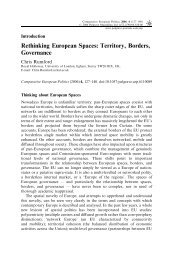Europeanisation, National Identities and Migration ... - europeanization
Europeanisation, National Identities and Migration ... - europeanization
Europeanisation, National Identities and Migration ... - europeanization
You also want an ePaper? Increase the reach of your titles
YUMPU automatically turns print PDFs into web optimized ePapers that Google loves.
1 Introduction<br />
Anna Tri<strong>and</strong>afyllidou <strong>and</strong> Willfried Spohn<br />
Introduction<br />
The decade following the European revolution of 1989–91 has witnessed a<br />
progressive, although in many ways difficult, reconnection of the divided Europe.<br />
With this development, the basic structural <strong>and</strong> cultural pluralism of a common<br />
‘European civilisation’ (Eisenstadt 1987) – damaged by the Second World War <strong>and</strong><br />
torn apart by the Cold War system – is in the process of restoration. This overall<br />
process includes particularly the restoration <strong>and</strong> re-organisation of the European<br />
system of nation-states <strong>and</strong> with them the redefinition <strong>and</strong> often intensification<br />
of national identities <strong>and</strong> reciprocal boundary constructions. The contemporary<br />
reconstruction <strong>and</strong> restructuration of nation-states in Europe, however, does not<br />
simply continue the thread of the pre-Second World War <strong>and</strong> pre-Cold War era<br />
of the modern nation-state. Rather, two major social forces are at work in contemporary<br />
Europe: the dynamics of European integration <strong>and</strong> the growing consequences<br />
of international migration <strong>and</strong> with them the transformation of national identities.<br />
The European integration process, on the one h<strong>and</strong>, has developed in deepening<br />
<strong>and</strong> widening movements in Western Europe since 1945, pooling <strong>and</strong> mediating<br />
the sovereignty of the participating member states. The imminent Eastern<br />
enlargement of the European Union will have similar impacts on the postcommunist<br />
nation-states of Central <strong>and</strong> Eastern Europe. As a consequence, the<br />
classical model of the nation-state as a sovereign entity of political-territorial centreformation<br />
is to an increasing degree in the process of modification. International<br />
migration, on the other h<strong>and</strong>, has for several decades had an impact on the most<br />
developed nation-states in Western Europe, yet in the last decade it has not only<br />
been intensifying, but its impact has also been increasingly felt in Southern <strong>and</strong><br />
Central Eastern Europe (see the chapters by Romaniszyn <strong>and</strong> Morawska in this<br />
volume). With it, the notion of cultural homogeneity as the basis of the politicallycentralised<br />
nation-state is to a growing measure modified by ethnic minorities<br />
<strong>and</strong> immigrant communities. Both of these processes of transnational modification<br />
of states <strong>and</strong> nations in Europe also manifest themselves – at least as a tendency –<br />
in a stronger weight of European <strong>and</strong> multicultural elements in collective identities.<br />
The contributions assembled in this volume address these two major social forces<br />
of transnational modifications of nation-states <strong>and</strong> collective identities in<br />
contemporary Europe in a Western <strong>and</strong> Eastern comparative perspective. Most



